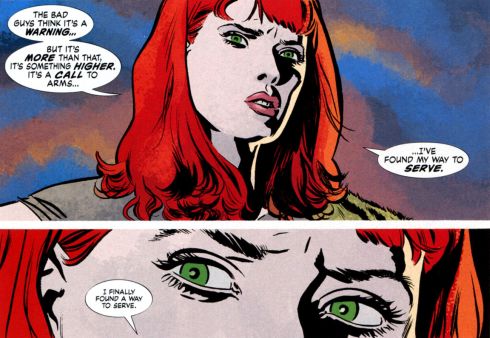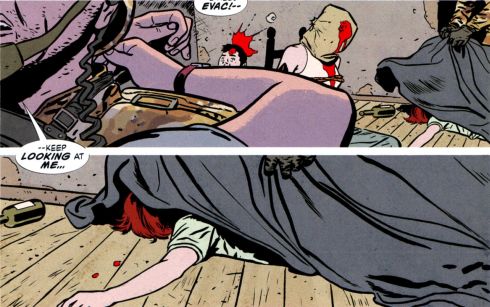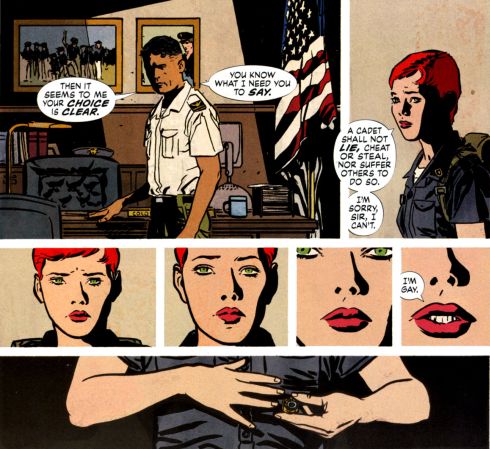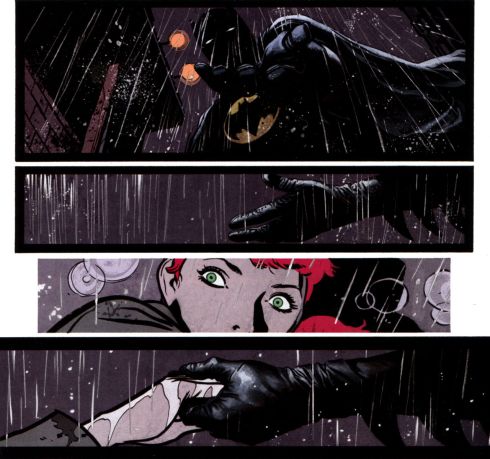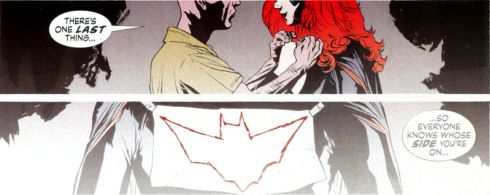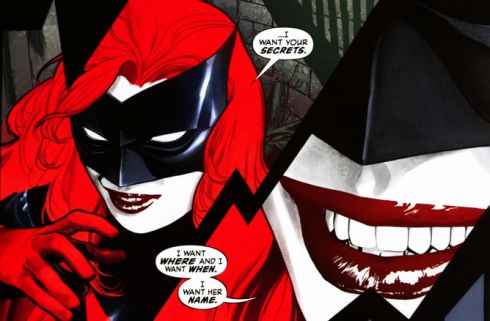The repeal of Don’t Ask Don’t Tell, the policy which bans open service in the United States military for homosexuals (it’s fully permitted in Canada), is on its way to the United States Senate for the second time. There’s been lots of debate about it recently! The stress related to its repeal, which is hospitalizing its activists, is due to dithering in the senate and some pretty bald-faced moving of the goalposts, which killed an earlier omnibus defense bill in that chamber. We’ve heard real gay soldiers tell us how it affects their ability to serve. Let’s take a look at one area it’s affected comics!
The modern incarnation of Batwoman, Kate Kane, drew headlines when it was announced she was a rarity in comics, a homosexual main character. She drew headlines again, when she helmed Detective Comics, one of the longest-running comics still going. And she drew headlines again when it was announced she was getting her own book. (That’s coming out in February–it’ll make her one of the only LGBT characters in mainstream comics to have her own book)
But what the press has tended to ignore is that she’s more than just a lesbian–she’s a Batbook hero. What makes most Batman heroes different is that they tend to lack powers and usually become heroes out of determination, honing their skills after years of mental and physical training. Bruce Wayne started a war on crime after his parents died, and trained Dick Grayson to be a crimefighter after he was also orphaned. Barbara Gordon, the first modern Batgirl, became Oracle after she was crippled by the Joker, at which point she devoted herself to relentless self-improvement. Tim Drake’s determination to become the world’s greatest detective drove him to discover both Wayne and Grayson’s secret identity and ask them to train him. (THEN his parents died.) Guess what motivated Kate Kane?
Identical twins Kate and Beth Kane were a pair of army brats who spent childhood moving from town to town, always changing friends and with parents whose army work kept them constantly busy. On their birthday, they and their mother were kidnapped by anonymous terrorists, who killed both her mother and Beth, but left Kate alive. Oddly in the Batworld, this didn’t lead Kane to become a vigilante right away. After all, the enemy was clear, and her family had always been united in one way–the service.
On graduation day from the United States Military Academy, Kane didn’t go out partying with her classmates, and stayed behind on post. Her roommate, the hilariously named Sophie “Gimme” Moore, went looking for her, and let her know that she wasn’t alone–with a kiss. But that doesn’t end well. The next week, Kane is called to the BTO’s office (by none other than Dan Choi, who helped with research for this story), who lets her know she is in breach of DADT–if she recants and says it was a mistake, she’ll face disciplinary action and find advancement a problem, but she’ll graduate. She does, as it turns out, what superheroes do–sticks to her guns.
She has the support of her father, who confirms that she kept her integrity and honour. But without the impetus to serve, she becomes a drifter–takes classes but can’t focus, drinks too much, and gets in fights with her girlfriend, who is a cop, over Kate’s lack of direction and Renee’s decision to serve in the closet. One night, she gets mugged on the streets of Gotham and almost goes too far taking out her anger on the would-be robber, until a chance encounter with a certain caped crusader.
Batman’s appearance reminds her that there is a field that she can use her experience in–vigilantism. Over the course of a year, she steals military supplies, runs intelligence, and then starts actively breaking up a gunrunning ring–not as a costumed hero, although her identity remains concealed through a gas mask. Eventually, her father the colonel shows up, and tries to convince her to give up crimefighting. When she refuses–see the top image–he relents and uses his contacts to, as is so familiar in Batman narratives, send her overseas for advanced, razor’s edge training. He sets up an advanced paramilitary structure to operate around her, and after two years, she is given her costume and the codename Batwoman by her father, the colonel.
So what can we learn from this story, as it applies to the American military? I mean, Batwoman is awesome, but she’s also a violent paramilitary vigilante who lives outside of established chains of command. That doesn’t work very well in the real world. The Batwoman story serves to remind us in a clear way that because Batman’s brand of costumed vigilantism doesn’t really work in the real world, the people who would be good material for that kind of superhero go into the military. This is what we’re talking about here–the service, whether it be the military or the police or whatever, is society’s outlet for superheroes. (This message sounds weird to anti-war types, but it’s the leadership you blame for wars, not the troops.)
What DADT does is take people who are relentlessly determined to self-improvement and purely driven by a certain type of belief system and violate their human rights before the word go. Then, you force them to either compromise their beliefs or quit. When they quit, they either become like Kate Kane would have been in the real world, without Batman–a waste of a good officer and great person bereft of their impetus to serve–or they could become like Kate Kane would be without a serviceable moral compass–someone who believes in themselves, but not the system they work for, and who may see a responsibility to take things into their own hands to make whatever changes they see fit–like, say, leaking 250,000 State Department cables. That’s the tragedy and the horror of this policy, and that’s what people should be thinking about as the bill moves towards the Senate.
The other lesson you should take from this: Buy Batwoman comics. She’s one of the raddest DC heroes out there right now–a credible woman hero who isn’t sexualised and succeeds in the Batman tradition of grim, brooding, adult bats. But DC has a habit of picking her up and putting her back down–her run in 52 gave way to sporadic appearances until she took the lead in Detective Comics, and her promotion to her own book ended up in her not being published for a year. Batwoman #0 came out last month, and the series starts in February–it’s drawn by J.H. Williams, the amazing artist of the Elegy run on Detective Comics, which you can also buy as a collected edition. It’s spooky, deals in the supernatural, and I thoroughly reccomend it.

